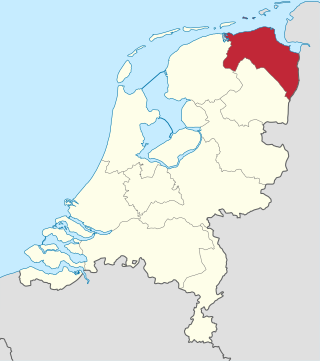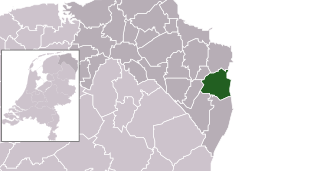
Groningen is the northeasternmost province of the Netherlands. It borders on Friesland to the west, Drenthe to the south, the German state of Lower Saxony to the east, and the Wadden Sea to the north. As of February 2020, Groningen had a population of 586,309 and a total area of 2,960 km2 (1,140 sq mi).

Bellingwedde was a municipality with a population of data missing in the province Groningen in the northeast of the Netherlands. Bellingwedde was established in 1968, when the municipalities of Bellingwolde and Wedde had merged. It contained the villages Bellingwolde, Blijham, Oudeschans, Veelerveen, Vriescheloo, and Wedde. After almost 50 year, Bellingwedde was disestablished in 2018, when the municipalities of Bellingwedde and Vlagtwedde had merged into Westerwolde.

Vlagtwedde is a village in the very southeast of Groningen province in the northeastern Netherlands. It lies on the Dutch border with the German state of Lower Saxony to the east.

Sportclub Veendam was a Dutch professional association football club based in Veendam, province of Groningen. Founded on 4 September 1894 as Look-Out, it became P.J. Veendam in 1909, Veendam in 1910, SC Veendam in 1974, BV Veendam in 1997 and again SC Veendam in 2011. The club was a founder member of the regional first tier Eerste Klasse Noord in 1916 and became champions of the division in 1931–32; it qualified for the national championship play-offs but finished in bottom place. Veendam took part in the inaugural season of the third tier Tweede Divisie in 1956–57; after yo-yoing between the third and second tiers, the team won promotion to the first tier Eredivisie for the first time in 1985–86. The side spent two seasons in the Eredivisie—1986–87 and 1988–89—but were relegated both times. Veendam then competed in the second tier Eerste Divisie until they were dissolved due to financial problems in 2013.

Sellingen is a village in the Dutch province of Groningen. It is a part of the municipality of Westerwolde, and lies about 25 kilometres (16 mi) northeast of Emmen. In 2021, statistical area "Sellingen", which also includes the surrounding countryside, had a population of 1,880, and the village of Sellingen had 1,045.

Munnekemoer is a hamlet in the Dutch province of Groningen. It is a part of the municipality of Westerwolde, and lies about 14 km northeast of Emmen.

Ter Wisch is a hamlet in the Dutch province of Groningen. It is a part of the municipality of Westerwolde, and lies about 20 km northeast of Emmen.

Bellingwolde is a village with a population of 2,655 people in the municipality Westerwolde in the Netherlands. It is situated in the southeast of the region Oldambt, in the north of the region Westerwolde, and in the east of the province Groningen, at the border with Germany.

Kloosterburen is a village in the Dutch province of Groningen. It is located in the municipality of Het Hogeland. The village developed around a monastery. Kloosterburen was a separate municipality until 1990, when it was merged with Leens, Ulrum and Eenrum. During the combining of the four municipalities they were called 'de LEUK gemeenten'. In 2019, it became part of Het Hogeland.

Wedde is a village in the municipality Westerwolde in the province Groningen in the Netherlands. It is located 9 km southeast of Winschoten. The castle Wedderborg is located in the village.

Bad Nieuweschans, previously named Nieuweschans (1868–2013), is an unstaffed railway station in the village of Bad Nieuweschans, Netherlands. It connects the Harlingen–Nieuweschans and Ihrhove–Nieuweschans railways and is situated between Winschoten, Netherlands and Weener, Germany.

Eurosonic Noorderslag is an annual four-day music showcase festival and conference held in January in Groningen, Netherlands. The first three days of the festival (Eurosonic) feature artists from all over Europe, the last day of the festival (Noorderslag) features only Dutch artists. The conference is held during all four days of the event. Several awards are presented during Eurosonic Noorderslag: the Music Moves Europe Talent Awards, the European Festivals Awards, the Buma Cultuur Pop Award (Popprijs), the Pop Media Award, The Feather, the "Iron Venue and Festival Animals" and the Buma Music Meets Tech Award.

Winschoten is an unstaffed railway station in Winschoten in the Netherlands. It is located on the Harlingen–Nieuweschans railway between Scheemda and Bad Nieuweschans in the province of Groningen.

The Bourtanger Moor was a bog in eastern parts in the Dutch provinces of Drenthe and Groningen and the bordering German districts of Bentheim and Emsland. A remaining stretch on the border between Drenthe and the districts Emsland and Betheim is now a nature reserve, the Internationaler Naturpark Bourtanger Moor-Bargerveen.

The Dagblad van het Noorden, abbreviated as DvhN, is a Dutch regional daily newspaper that is published and circulated in the provinces of Groningen and Drenthe in the northeastern Netherlands. The newspaper is owned by Mediahuis. Erik Wijnholds has been editor-in-chief since 2017. It had a circulation of 96,515 copies in 2015.

Museum de Oude Wolden, abbreviated as MOW, is a regional museum in the village of Bellingwolde in the Netherlands. The museum focuses on art and history of the regions of Oldambt and Westerwolde in the east of the province of Groningen.

The Rechthuis is a former courthouse in the village of Bellingwolde in the Netherlands. The building with two crow-stepped gables was established in 1643 and used as a civil court for the area Bellingwolde-Blijham until 1811. The building has been a national heritage site since 1972. It is currently used as a private residence.

Westerwolde is a municipality in the province of Groningen in the northeast of the Netherlands.
Mediahuis Noord, formerly known as NDC Mediagroep, is a Dutch publisher of newspapers, magazines, and websites focused on the three northern provinces of the Netherlands: Drenthe, Friesland and Groningen. It is owned by Mediahuis, a Belgian company. Headquarters are in Leeuwarden, other offices are in Groningen and Meppel. In addition to three main provinces, NDC publishes and distributes also in the Kop van Overijssel, Noordoostpolder, and northern Flevoland.

Visvliet is a village in the Dutch province of Groningen. It is part of the municipality of Westerkwartier, and is located near the river Lauwers, the border between Friesland and Groningen.























